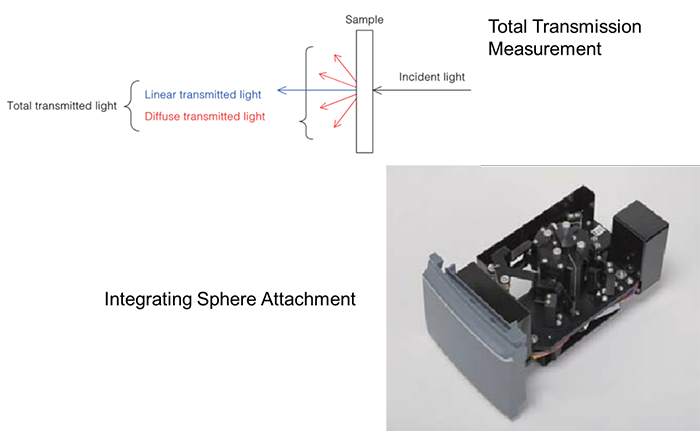What is a total transmission measurement?

Total transmission measurements measure all of the light passing through a sample, combining the linear transmitted light and diffuse transmitted light. The top left figure shows a schematic view of the measurement. A spectrophotometer fitted with an integrating sphere is used for the measurements. Therefore, such measurements are sometimes called "integrating sphere measurements." The bottom right figure shows an example of an integrating sphere attachment used for such measurements.
When a transparent sample is measured, total transmission measurements acquire the same data as linear transmission measurements because there is no scattering of diffuse light in the sample. If the sample is adequately thin, linear transmission measurements provide data with less noise. This is because much of the light entering the integrating sphere used for total transmission measurements does not reach the detector. Several types of integrating spheres are available for measurements. The sizes of the integrating spheres can differ dramatically. A 60-mm-diameter integrating sphere is normally used but a large 150-mm-diameter integrating sphere attachment is also available. Integrating spheres dedicated to transmission measurements are also available with different numbers of openings. Such transmission integrating spheres are suited to the measurement of samples when the focal point differs considerably between baseline correction and sample measurement.
For total transmission measurements, care must be taken when comparing measured data. It is sometimes impossible to accurately compare data measured using different integrating spheres. This situation often occurs with samples that scatter light and create a lot of diffuse transmitted light. For baseline correction, the light incident on the integrating sphere first hits a standard white plate and makes multiple reflections inside the integrating sphere before reaching the detector. During sample measurements, however, the light first hits the interior of the integrating sphere before it reaches the detector. Consequently, differences occur in the data due to differences in reflectance at the position of the first reflection. When comparing total transmittances, you are recommended to use data measured with the same integrating sphere.


